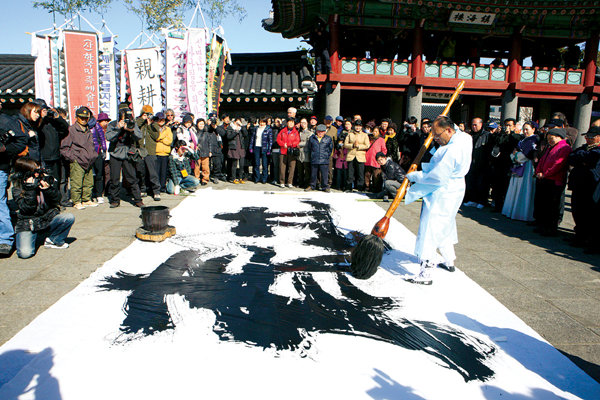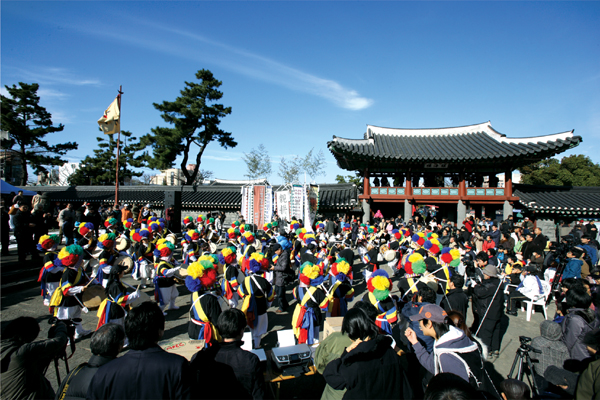

Feb. 16 (Jeju Weekly) Spirits were high in Jeju City at the weekend as the island welcomed spring 2010 with the Tamnaguk Ipchungutnori. Ipchun, which commonly falls on Feb. 4, is one of 24 seasonal divisions in the solar calendar and marks the onset of spring. The Ipchungut, or Ipchun Shamanic ritual, derives from rites held at village shrines throughout the island each year to ask the gods for a bountiful harvest. The Ritual has been passed down from the Tamnaguk, or Tamna kingdom, which was an independent state on Jeju Island between the 7th and 11th centuries.
Hosted by Jeju City and managed by Jeju Min-yea-chong, the celebration began at City Hall in the early evening of Friday, Feb. 5, before wending its way through the lower part of the city to Gwandeokjeong, where festivities continued the following day. Pamphlets available in both Korean and English stated that the tradition had died out during the Japanese occupation of Korea but was reintroduced in 1999 due to its significance as a precious intangible cultural asset.
 | ||
The area in front of City Hall was a riot of color by 4:30 p.m. when the event began with pungmul troupes from 18 villages warming up for each group’s turn to display their musical and dancing skills center stage. A central part of the festival is the nangsha, or wooden cow, which began the festival displayed at the top of the steps leading into City Hall, with traditional masks laid out on the steps and an offering table, similar to those used by Korean families during the Jesa ritual at Chuseok, lower down. Participants dressed in a range of clothing, ranging from ornate nobles’ robes and the more sedate garb of officials through Confucian monks’ vestments to simple galot clothes - the tough, persimmon-dyed garments traditionally worn as everyday working wear on Jeju. One group led a smaller cow figure around and another was dressed as a hunter with a rifle on his shoulder and a brace of pheasants slung across his back.
Once the speeches were given and a Confucian rite performed for the wooden cow, it was led, on its wheeled platform, down to the road ready for a procession to Gwandeokjeong near Jungang Rotary, which was the provincial government’s base during the Joseon Dynasty. Pungmul troupes both led the way and followed the cow, which was pulled and pushed through the Friday night traffic. Jeju’s police did an admirable job of trying to minimize the chaos caused by hauling a heavy cow along sometimes potholed roads but frequent sit-downs by those doing the hard labor as they demanded makgeolli and food to sustain their efforts didn’t lessen the disruption.
 | ||
On arrival at Gwangdeokjeong, the cow was manhandled into a prominent resting place and there were more speeches and dancing before the festival-goers headed to food tents to eat Ipchun noodles. (It is believed that eating noodles on Ipchun drives away bad luck.)
The next day dawned crisp and clear with a cloudless sky allowing the warmth of the sun to counteract the chill breeze off a snow-capped Mount Halla. Adults and children meandered through the environs of the Gwangdeokjeong complex, watching and taking part in the many activities on offer. These included masked dances and musical performances, a beautifully choreographed tea ceremony, traditional children’s games and the opportunity to make your own model nangsha or other craftworks.
There were few Westerners to be seen at either the Friday evening or Saturday events and Hong Sun Young, who was in charge of promotions, said there were more foreigners present last year. She was unsure of the reason but said the organizers were happy overall with the number of festival-goers. “One of the aims of the festival is to bring more people into the festival,” she said. “It doesn’t matter what kind of people. We just want anyone to come and to enjoy it.”
 | ||
At 11 a.m. Saturday, the sound of drums and gongs marked the start of the Ipchungut itself and drew visitors to a pavilion outside the complex walls, where the chief shaman invited the shrine gods of all Jeju City’s villages to ask them to protect the welfare and wellbeing of the city. The gut had five stages and featured intricate and intriguing choreography, singing, music and dance.
Festival-goers could also have their fortunes told or write out their wishes for the year to come on paper provided and hang them from the ropes fencing in the wooden cow. The cow used in the festival is made anew each year and nangsha from previous Ipchungutnori had been put out to pasture within the walls of the complex, where this year’s beast will soon join them.




No comments:
Post a Comment